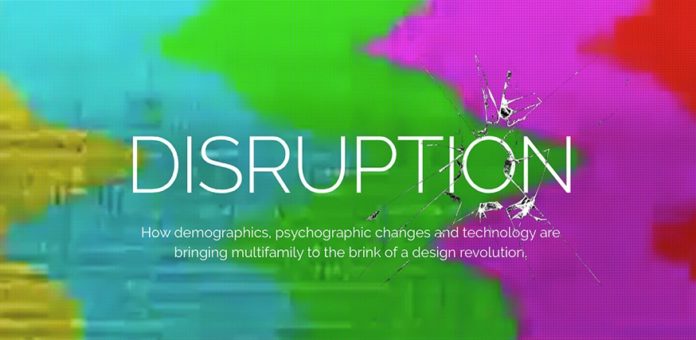The National Multifamily Housing Council (NMHC) has released the 2018 Consumer Housing Insights Survey, alongside an in-depth trends report, Disruption: How Demographics, Psychographics, and Technology are Bringing Multifamily to the Brink of a Design Revolution with visualizations of how the industry could respond to the coming waves of disruption, which were brought to life in partnership with KTGY Architecture + Planning.
The newly released research and renderings underscore the need for developers, investors, property managers and architects to adapt to the shifting demographics and psychographics of the renter population in order to effectively meet the demand for 4.6 million new apartment units by 2030.
“The multifamily industry needs to catch up with the revolutions that are already well underway in everything from transportation and retail to demographics and psychographics,” Rick Haughey, NMHC’s vice president for Industry Technology Initiatives, said. “With a population that is aging and growing more diverse, which is impacting household composition, now is the time for our industry to adapt and build to meet the needs of the future.”
Data reveals in-demand amenities for the future
Findings from the 2018 Consumer Housing Insights Survey illuminate the growing need for flexible living spaces, personalization, healthy living features and amenities, convenience and connectivity in apartment homes.
When it comes to personalization and flexibility, respondents noted adaptation is key. Eighty-three percent of respondents believe it is important to have a space that evolves with different stages of your life while seventy-eight percent believe it is important to have a space that can transform to meet different needs.
And, while technology is important, it isn’t everything. Despite strong interest in reliable cell reception and access to high speed internet, respondents noted face-to-face interaction is still important in a digital world. Eighty-three percent of respondents believe places to socialize face-to-face with friends and family is an important housing feature.
The disruptive forces facing the real estate industry such as the sharing economy, are chipping away at the divide between public and private space, requiring tomorrow’s apartment communities to be integrated into the fabric of the larger community. Data from NMHC’s 2018 Consumer Housing Insights Survey found that fifty-eight percent of Millennials believe apartments should provide helpful services and amenities for the surrounding community.
This research will serve as the platform for further creative exploration of how multifamily design can better adapt to these shifts moving forward, minimizing the degree of disruption the industry is bound to face.
Take a look at the apartment of tomorrow
To illustrate the seismic shifts poised to disrupt the multifamily industry and help developers, property managers, investors and architects envision the apartment of tomorrow, NMHC partnered with KTGY Architecture + Planning to develop eight videos that showcase futuristic living spaces to create, consume, amuse and refresh. The eight designs, which include both private living areas and shared amenity spaces, offer innovative and imaginative takes on what apartment living will look like for the next generation. Features such as moveable walls, interactive fitness and wellness amenities, and 3D printers are just some of the highlights of these futuristic spaces.
Source: 2018 Consumer Housing Insights Survey
As part of the supporting data for the NMHC report “Disruption – How Demographics, Psychographics and Technology are Bringing Multifamily to the Brink of a Design Revolution” NMHC commissioned market research conducted by Beck Research.
The National Survey questioned 1,000 adults with emphasis on renters and millennials. Key findings include:
- Americans have difficulty describing the apartment of the future and describing a space beyond the status quo. Instead Americans advocate for improvements to current services and amenities.
- Technology, in the form of strong cell service or fast internet access, is a requirement for modern apartments or any housing arrangement.
- Americans want more amenities at their fingertips. They are interested in features in apartments, such as better appliances and washer/dryers, as well as community features, such as outdoor spaces and gyms.
- The core benefits of rental apartments remain convenience, flexibility and the ability to move. Rental apartments are “a space that evolves with different stages of your life” (83 percent say important).
- Millennials are more likely than older Americans to see rental apartments as “innovative,” see a broader community role for apartments, and agree that “my community is stronger when there is a mix of rental apartments and single-family homes.”
- Millennials are more social and more attached to the urban centers. They are more likely to listen to live music, but also value face-to-face communication.
- Suburban Americans “underperform,” meaning Suburban Americans favor the Democrats by a wide 16-point margin, but act similar to Fringe areas, which favor Republicans by 12-points. Both are very skeptical of apartments
Consumer Housing Insights Survey highlighted in the Disruption report include:
- Nine out of 10 survey respondents (92 percent) said convenience was important to them;
- Nearly two-thirds (63 percent) agreed that their lives were so hectic that they look for ways to make things easier;
- “My life is so hectic that I look for ways to make it easier for me”
- Ninety-four percent of respondents said that being able to personalize their space was important.
- Eighty-three percent stressed the importance of having space that evolves with different stages of their lives.
- More than three-quarters (78 percent) said they valued having a convertible space that could transform to meet different needs
- 40 percent of respondents said they plan to telecommute more in the future; and
- 60 percent said their home was a reflection of their identity.














